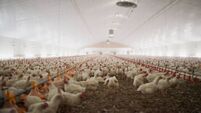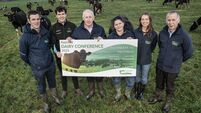Government sets out next phase of agriculture emission target plans

In 2023, lime usage fell to only one million tonnes, the decrease being mostly attributed to poor weather conditions in the second half of the year.
This year, the Government will encourage lime application, even though spreading more lime will increase greenhouse gas emissions.
Liming of soils decreased by 26.6% in 2023, which helped to reduce overall emissions from agriculture by 4.6%. But the main cause of the reduction in 2023 is believed to be an 18% fall in fertiliser nitrogen use on Irish farms, leading to 0.43 million metric tons of carbon dioxide equivalent fewer emissions from agricultural soils.
The 26.6% decrease in liming, plus a 2.1% reduction in methane from enteric fermentation in livestock (the cattle population fell 1.2%), were together estimated to cause a further 0.46 MtCO2eq fewer emissions.
In 2023, lime usage fell to only one million tonnes, the decrease being mostly attributed to poor weather conditions in the second half of the year.
Liming causes carbon dioxide emissions, but it improves soil fertility, leading to sustained reductions in fertiliser usage, and therefore a net reduction in emissions.
Other actions planned this year to reduce agricultural emissions are listed in the Government's recently published third Climate Action Plan.
Reducing dependence on nitrogen fertiliser is also the objective of support this year for the establishment of multi-species and clover swards. Optimising nutrient management strategies will also be promoted among farmers in order to reduce gaseous emissions.
Organic farming expanded to 220,000 ha in 2024, 5% of usable agricultural land (the 2030 target is 10% of land farmed organically).
The 60% grant-aided Nutrient Storage Scheme has already been launched in the latest tranche of the Targeted Agriculture Modernisation Scheme (TAMS 3) — it will support reduced reliance on chemical fertiliser.

The 14% maximum allowable crude protein in concentrates fed to adult cattle at grass from April 15 to September 30 already applies.
This year, farmers can also expect measures to encourage the usage of inhibited (protected) urea.
There will be increased focus on feed additives to reduce methane from cattle, with research continuing into their use for pasture-based systems (including assessment over the lifetimes of animals, and methods of administering them at pasture).
On signpost dairy farms, the Department of Agriculture will roll out a wider pilot programme for incorporating methane-reducing (enteric and manure) additives. There will also be work to optimise animal breeding strategies for low methane.
Specifically in the beef sector, an action plan for reducing the age of cattle slaughter is in this year's climate plan (age at slaughter increased in 2023, attributed to difficult weather in the grazing season).
The Food Vision Tillage Report plan, to increase the tillage crops area and enhance the environmental footprint of the sector, will be progressed in 2025 (the tillage area reduced by 1% in 2024).
The Government will continue to support and develop AgNav, which is a Bord Bia, Teagasc and ICBF collaboration to help deliver climate action plan targets.
Away from the main farming enterprises, funding mechanisms will be identified for measures such as reduced management intensity of grassland on drained organic soils, longer forest rotations, and improved grassland management, all designed to reduce land use emissions. Complementary Acres cooperation actions will be launched with the same objective.
The potential to increase the 2030 target of an additional 30,000ha of peatland rehabilitation will be explored, and Peatland Finance Ireland will be supported to attract finance to peatland restoration, helped by the development of a peatland standard for Ireland.
The Government will fund geospatial drainage status detection mapping of organic-rich soils.
Along with raising awareness among forest owners of the impact of timing when deciding to harvest their forest, 2025 will bring a midterm review of the 2023-2027 Forestry Programme, and work to deliver the Coillte Forest Estate Strategic Land-Use Plan. Development of the National Restoration Plan will also pick up this year.
Introduction this year of the Renewable Heat Obligation, requiring energy suppliers over a certain threshold to produce more renewable energy, will incentivise Irish production of biomethane.
Along with wind and solar, biomethane can contribute towards the climate commitment to increase the share of renewable electricity to 50% by 2025, and 80% by 2030. It is already more than 40%. Ramping up approval of renewable energy projects is seen as crucial for reaching national emissions targets.
Even after reductions in the past year, agriculture remains Ireland's highest-emitting sector, at 34.3%. The estimated total reduction from 2018 to 2023 is only 2.9%, making the 2030 target of a 25% reduction a significant challenge, exacerbated by chemical nitrogen sales estimated to have increased 11% in 2024, compared to 2023.
The Climate Action Plan 2025 is the third annual statutory update to Ireland’s Climate Action Plan. It provides a roadmap for reducing national greenhouse gas emissions by 51% by 2030 and achieving climate neutrality by no later than 2050.












